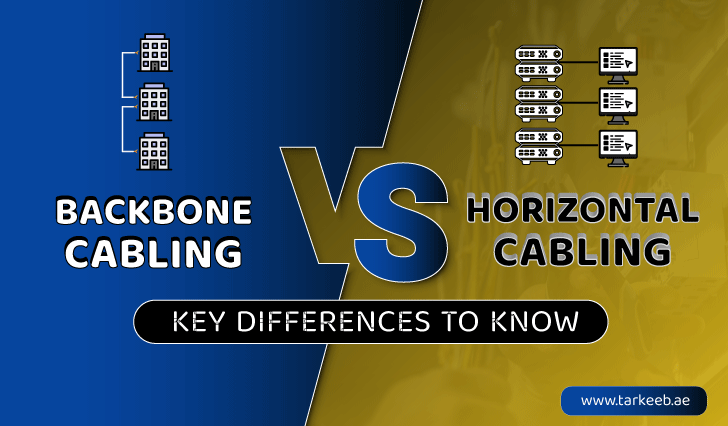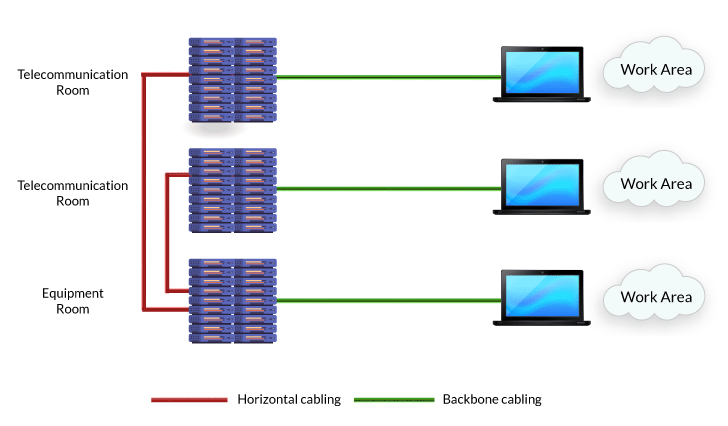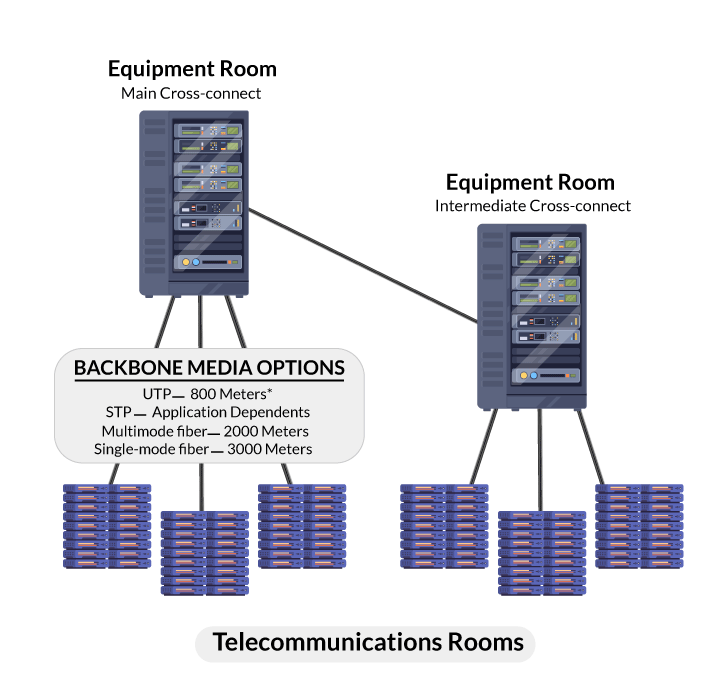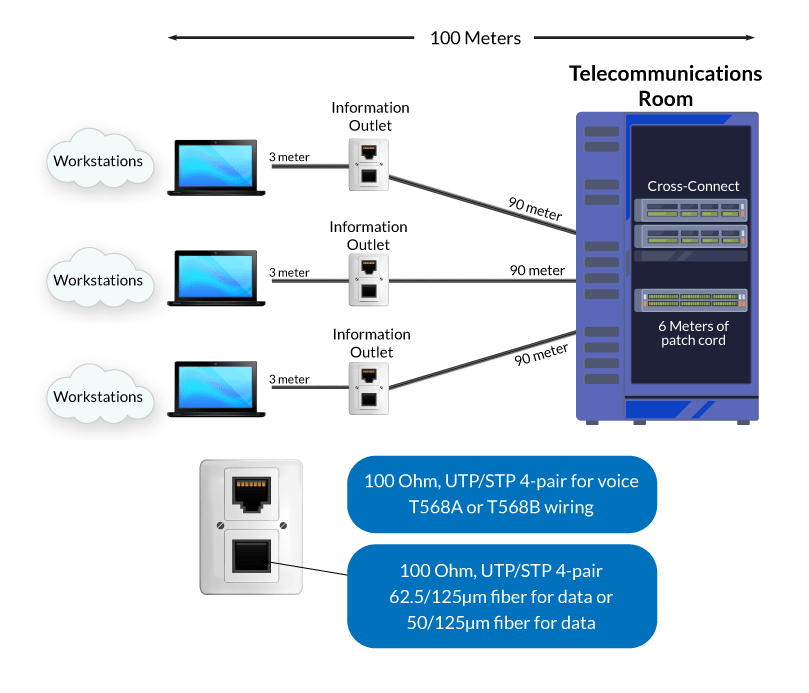
Business and academic settings are incomplete without proper communication architecture. The cabling game has evolved, and industries should catch up to keep the infrastructure updated. Gone are the days when copper used to be the epitome of communication channels, and specialists would spend hours waiting for the network to send/receive files. However, with the invention of modern-day tools like fiber optics and structured cabling systems, the communication infrastructure has developed enough.
The wheel does not stop at structured cabling and fiber optic cables as it rolls on to new terms like backbone and horizontal cabling. To understand backbone vs. horizontal cabling, it would be best to roll through the subsystems of structured cabling to develop your base. Let us jump onto the next portion to understand the terms and their usability in communication infrastructure.
Backbone cabling (vertical cabling) refers to a cabling system that supplies telecommunication access to different spots within a complex or facility. The cabling system facilitates the exchange of information among numerous location points by using wired access. When you dig deeper into the interconnection between entrance facilities, equipment rooms, and telecom rooms, you will find backbone cabling installed at the core center of these points.
You probably have been waiting for a standard definition of backbone cabling, and here it is:
“The function of the backbone cabling is to provide interconnections…Backbone cabling consists of the backbone cables, intermediate and main cross-connects, mechanical terminations, and patch cords or jumpers used for backbone-to-backbone cross-connection. Backbone cabling also includes cabling between buildings.” The definition was given by Telecommunications Industry Association (TIA).
Fiber optic cable is probably the most appropriate backbone cabling and is widely used. These cables provide much better bandwidth and performance than CAT5, CAT6, and even CAT7 twisted-pair copper cables. Moreover, fiber cables can run much longer distances than their counterparts, making them suitable for backbone cabling.
Backbone cabling is not a standalone structure but consists of numerous essential components. These components are no less than pillars of the entire infrastructure and are explained here:
The diagram will help you see how the equipment and telecommunication rooms are connected through backbone cabling. Since backbone cabling provides interconnections between different points, a commercial building is well-off with this setting. It will show up like the following image.


Horizontal cabling extends from the telecommunication rooms to deliver data/information to individual work areas or workstations. Horizontal cabling is often installed in a star topology that connects each work area to the telecommunication room. However, one thing to remember is that horizontal cabling must not exceed 90 meters in length between Work Area Outlet and the termination point. Doing so means showing compliance with TIA Standards, which can keep your network green and running.
Horizontal cabling often uses copper cabling like CAT5e and CAT6a as the common cables; however, fiber optic and coaxial cables are also used sometimes. Horizontal cabling often runs straight through the floor and must be installed during the construction or renovation of a building.
Backbone and horizontal cabling are quite different regarding covering telecom service areas. Understanding the network topology and getting these cabling systems to work might test your technical skills. However, you don’t need to worry if you lack these skills, as professional structured cabling companies in Dubai can help you on this matter. You better consult them!
Horizontal cabling can consider the use of Ethernet and fiber optic cables for smooth operations. However, other cable types can also be used for voice and data transmission. The former uses Four-pair 100-ohm unshielded twisted pair (UTP) cable (CAT5e, CAT6, or CAT6a cables), while the latter uses fiber optic cable (two-fiber 62.5/125-micron or 50/125-micron multi-mode cable.
Horizontal cabling is usually installed in a star topology (as shown in the figure), which connects each work area with telecom rooms. The system includes the following points that you must remember while examining this system:

Backbone cabling usually connects entrance facilities and equipment rooms, whereas horizontal cabling covers a building’s individual work areas and stations. The main difference you will see between these two cabling systems is regarding the area that they cover. Some of the key differences are highlighted in the coming portion to help you better understand the two systems.
As specified, backbone cabling covers and connects different service areas compared to horizontal cabling. The former is to connect entrance facilities, equipment rooms, and telecommunication rooms. However, the latter is concerned about connecting telecommunication rooms to individual outlets on the floor.
Although these two systems use the same cables (almost), backbone cabling has different requirements. Backbone cables are typically OFNR (Optical Fiber Non-Conductive Riser) rated and must adhere to strict fire-rating requirements. The backbone cable must be OFNP (Optical Fiber Non-conductive Plenum) certified if it travels through plenum areas (areas in the building used for air return in air conditioning).
Additionally, backbone cables’ cable strength differs from horizontal cables since backbone cables must be strong enough to carry their weight. Furthermore, backbone cables need to be properly secured, unlike horizontal cables.
Backbone and horizontal cabling also differ regarding structure. Backbone cabling often runs through the building floor and to different buildings when needed. However, horizontal cabling is limited to ONE floor, the same floor as the telecommunication room. Running horizontal cables between floors is possible but not recommended as it can degrade the network performance.
Choosing the right cabling system from the two can be hectic as the decision will test your technical skills. After you have gone through the core differences and structural anatomies of backbone and horizontal cabling, picking the right one should not be a great deal.
Having a trained cabling contractor to design and install your cabling infrastructure is crucial because backbone and horizontal cabling are essential parts of structured cabling. A poor design and installation job might result in various expensive and annoying issues for your company. Why not allow our specialized structured cabling experts in Dubai to help your cause?
The equation is simple! Backbone cabling should be your go-to option if you need to connect entrance facilities, equipment rooms, and telecom rooms. However, if you are looking to get workstations online, horizontal cabling is what you need. The best idea is to assess your project or networking needs and opt for a cabling system accordingly!
Choosing and installing a particular structured cabling type in your house/organization is a technical task. However, you don’t need to worry, as Tarkeeb could be your partner in cabling! You can trust the brand with years of experience installing and designing structured cabling for different organizations. Contact us today to set up the cabling game for your organization!
Backbone cabling, also known as vertical cabling, provides interconnection between telecommunication rooms, entrance facilities, and equipment rooms. The cabling system is installed from floor to floor and always uses fiber optic cables as they provide better bandwidth and performance.
The core point that defines the line between these two terms is the area of service they cover. You can use backbone cabling if you want to connect entrance facilities, equipment rooms, and telecommunication rooms. However, horizontal cabling connects telecommunication rooms to the workstation outlets.
Backbone cabling always uses fiber optic cables as they provide better bandwidth. Fiber optic cables are used because of their efficiency, bandwidth, and ability to run long distances, outfoxing CAT5 and CAT6 cables.
Horizontal cabling is used to connect telecommunication information outlets and workstations. The cabling system extends to the telecommunication enclosure and telecom room. Ethernet and fiber optic cables are commonly used to build this cabling structure across buildings.
Horizontal cabling uses Ethernet and fiber optic cables for operations. The Four-pair 100-ohm unshielded twisted pair (UTP) cable (CAT5e, CAT6, or CAT6a cables) is used for voice. Fiber optic cables (two-fiber 62.5/125-micron or 50/125-micron multi-mode cables are used for data transmission.
The maximum allowable distance for horizontal cabling is 76 meters (250 feet). However, it can also be stretched to 90 meters, but it shall not exceed the limit if it is to comply with the TIA standards.
Recommended Posts:
Structured Cabling System: Types, Subsystems, Standards & Uses
Various Benefits of Structured Cabling Systems
Different Types of Fiber Optic Cables: Essential Guide
How To Improve Your Home Security System?
What Is Home Automation, And It’s Working?